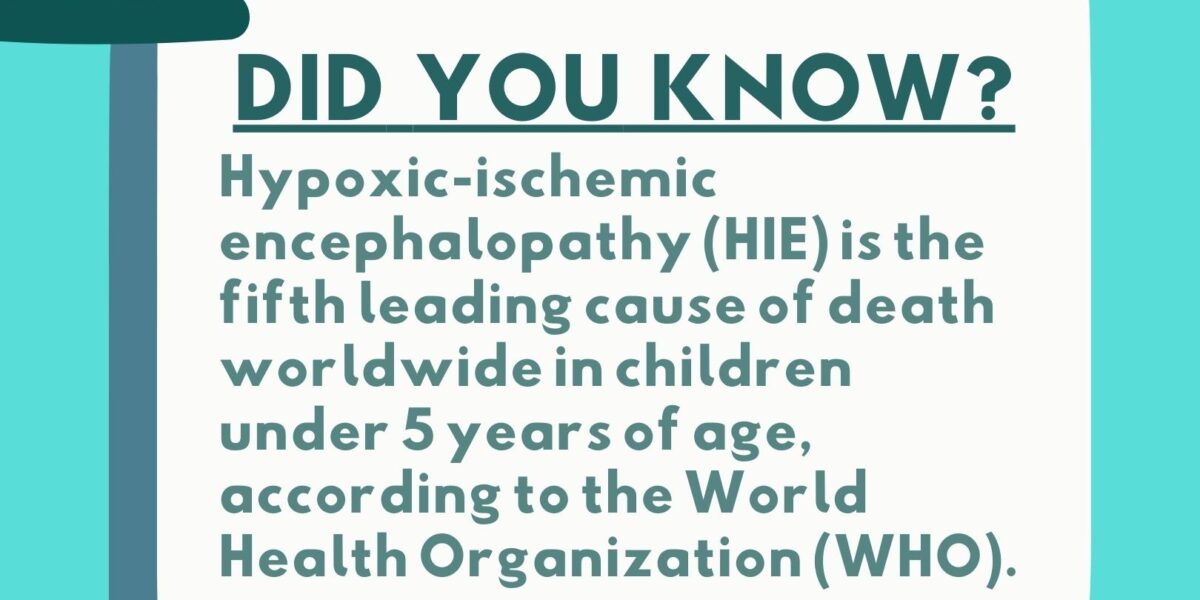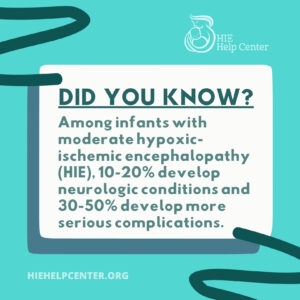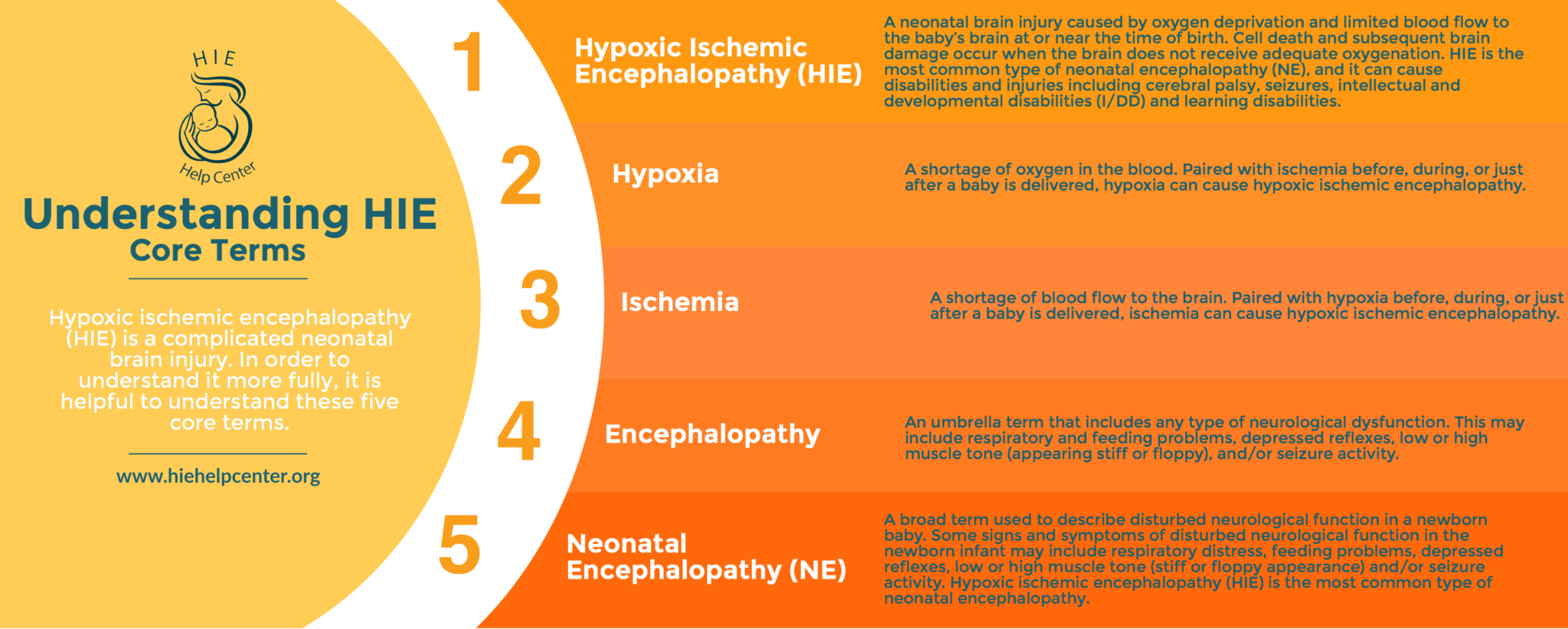Hypoxic-ischemic encephalopathy (HIE) is a type of brain damage caused by limited flow of oxygenated blood. In many cases, HIE is the result of a birth injury; that is, a medical complication or malpractice during or around the time of birth. The terms birth asphyxia* and neonatal encephalopathy* are sometimes used synonymously with HIE, although they do not have completely identical meanings.
How common is HIE?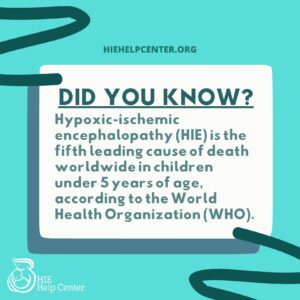
- Neonatal HIE is estimated to occur in about 1.5 per 1,000 live births (1).
- The incidence of HIE is higher in countries with limited resources; birth asphyxia* causes 23 percent of neonatal deaths worldwide (2).
- HIE is the fifth leading cause of death worldwide in children under 5 years of age, according to the World Health Organization (3).
What are the causes of HIE?
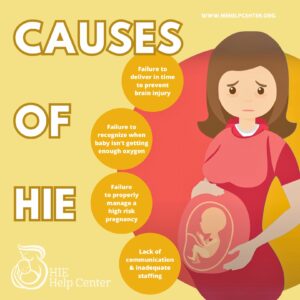 Hypoxic-ischemic encephalopathy (HIE) often occurs as the result of an oxygen-depriving event in the prenatal, intrapartum (during birth), or postnatal period. Some of the most common risk factors and causes of HIE include the following:
Hypoxic-ischemic encephalopathy (HIE) often occurs as the result of an oxygen-depriving event in the prenatal, intrapartum (during birth), or postnatal period. Some of the most common risk factors and causes of HIE include the following:
- Mismanaged high-risk pregnancy
- Intrauterine growth restriction (IUGR)
- Uterine rupture
- Placental complications
- Umbilical cord issues
- Fetal monitoring errors
- Delayed emergency C-section
- And more
What is the prognosis for children with HIE?
Prognoses vary greatly depending on the severity and extent of hypoxic-ischemic brain damage, and also on how the medical team treats the baby after the injury.
- Infants with mild HIE generally survive and often do not develop and serious, lasting effects.
- Among infants with moderate HIE, 10-20 percent develop minor neurological conditions, and 30-50 percent develop more serious complications.
- For infants with severe HIE, there is a 25-50 percent mortality rate. Deaths most often occur in the first few days after birth. Of babies that survive, roughly 80 percent develop serious complications.
What conditions commonly co-occur with HIE?
 Some of the most commonly associated conditions include the following:
Some of the most commonly associated conditions include the following:
- Cerebral palsy: Approximately 30 percent of children with moderate-severe HIE develop cerebral palsy.
- Epilepsy: Approximately 16 percent of children with moderate-severe HIE develop epilepsy.
- Vision/hearing issues: Approximately 14-17 percent of children with moderate-severe HIE experience blindness, and 6 percent have hearing impairments (3).
- Cognitive impairment: Early studies on children with HIE suggested that cognitive impairments did not develop in the absence of physical issues such as cerebral palsy. However, more recent research has shown that this is not the case; cognitive impairment can accompany physical disabilities or occur on its own (4).
What treatments for HIE are available?
- The most important treatment for HIE is therapeutic hypothermia, in which a newborn’s brain is cooled in order to slow the spread of cell injury and minimize (or in some cases even prevent) permanent damage.
- Hypothermia therapy should be started as soon as possible after the hypoxic-ischemic injury; current guidelines recommend that it be begun within six hours of birth (5).
- Hypothermia is the routine treatment for moderate to severe HIE.
- There are also a variety of treatments that may benefit older children with HIE and related disabilities; these are not cures, but can improve function and minimize negative symptoms.
Terminology
*Birth asphyxia is a condition of impaired blood gas exchange and oxygen deprivation. HIE is then characterized by the clinical signs and laboratory results that indicate brain injury from birth asphyxia.
**Neonatal encephalopathy is a broad term used to refer to neonatal brain damage. Technically, it is an umbrella term encompassing HIE, but is also sometimes used to specifically refer to HIE.
About the HIE Help Center and ABC Law Centers
The HIE Help Center is run by ABC Law Centers, a medical malpractice firm exclusively handling cases involving HIE and other birth injuries. Our lawyers have over 100 years of combined experience with this type of law, and have been advocating for children with HIE and related disabilities since the firm’s inception in 1997.
We are passionate about helping families obtain the compensation necessary to cover their extensive medical bills, loss of wages (if one or both parents have to miss work in order to care for their child), assistive technology, and other necessities.
If you suspect your child’s HIE may have been caused by medical negligence, please contact us today to learn more about pursuing a case. We provide free legal consultations, during which we will inform you of your legal options and answer any questions you have. Moreover, you would pay nothing throughout the entire legal process unless we obtain a favorable settlement.
You are also welcome to reach out to us with inquiries that are not related to malpractice. We cannot provide individualized medical advice, but we’re happy to track down informational resources for you.
Sources
- Kurinczuk, J. J., White-Koning, M., & Badawi, N. (2010). Epidemiology of neonatal encephalopathy and hypoxic–ischaemic encephalopathy. Early human development, 86(6), 329-338.
- Zanelli, S. A., Stanley, D. P., & Kaufman, D. A. (n.d.). What is the global prevalence of hypoxic-ischemic encephalopathy (HIE)? Retrieved March 28, 2019, from https://www.medscape.com/answers/973501-106461/what-is-the-global-prevalence-of-hypoxic-ischemic-encephalopathy-hie
- Hypoxic-Ischemic Encephalopathy. (2019, February 03). Retrieved March 28, 2019, from https://emedicine.medscape.com/article/973501-overview#a2
- Gonzalez, F. F., & Miller, S. P. (2006). Does perinatal asphyxia impair cognitive function without cerebral palsy?. Archives of Disease in Childhood-Fetal and Neonatal Edition, 91(6), F454-F459.
- The Academica Medical Center Patient Safety Organization (AMC PSO) Neonatal Encephalopathy Task Force. (2016). Therapeutic Hypothermia in Neonates: Recommendations of the Neonatal Encephalopathy Task Force[Pamphlet]

